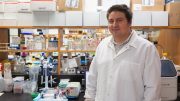The child was born in rural Mississippi in July of 2010. The mother was infected with HIV, a fact that the doctors were unaware of until a test was given while she was in labour. Although antiretroviral treatment has made the transmission of HIV from mother to child very rare, in this case there was no chance to treat the mother before the baby was born. Because the baby was premature, she was moved to the University of Mississippi Medical Center (UMMC) in Jackson. Two HIV tests were then performed that ordinarily would have taken up to six weeks. These tests confirmed the presence of an HIV infection, and the baby was started on anti-HIV drugs 31 hours after birth.
The first three follow-up tests still showed HIV in the baby’s plasma, but by the fourth test, at 29 days after birth, the infection had become undetectable. At 18 months the parents stopped treatment for reasons that have not been disclosed, and at 21 months, when the baby returned for medical care, a UMMC doctor was unable to find HIV or HIV antibodies on standard tests. The doctor, Hannah Gay, sent blood samples to a team at Johns Hopkins University to have them tested more thoroughly. The Hopkins team, led by paediatrician Deborah Persaud, first examined the samples 24 months after the baby’s birth. They found only one copy of HIV RNA, likely a defective version of the virus that cannot copy itself.
Persaud’s team mixed the blood samples with uninfected CD4 cells – the cells targeted by HIV. Tests at 26 months found traces of the virus, but it had not mixed with the cells, indicating that it was incapable of copying itself. Persaud believes that the early intervention prevented infected CD4 cells from accumulating. These cells contain a latent form of the virus that is not detected by the immune system or targeted by drugs.
The child may still have an infection. At the moment this is being called a “functional cure” rather than a “sterilizing cure”; a sterilizing cure would mean the definite eradication of all HIV from the patient’s system. Still, this child’s case has made many hopeful about the future of HIV research.
“This is one case and we definitely need to have more, and hopefully we can have more,” said Persaud.
This is actually the second case of a human being cured of HIV. The first is Timothy Brown, a 46-year-old American man living in Germany known as the “Berlin patient.” Brown found out he was HIV positive and began treatment with the anti-HIV drug AZT in 1995. In 2006, however, he received even more bad news: he had developed a highly lethal form of leukemia, independent of his HIV. When Brown was given a bone marrow transplant for the leukemia, the doctors found a donor with a genetic mutation known as delta 32, which prevents HIV from infecting CD4 cells. The doctors were not sure what would happen, but Brown’s HIV infection apparently disappeared. At present, he is free from leukemia and no traces of HIV can be found in his body.
Although Brown’s cure is only of value to those unfortunate enough to have HIV and leukemia at the same time, this new case has a much broader applicability.
“This has very important implications for paediatric HIV infection and the ability to achieve cure,” said Persaud.
If research into this phenomenon pans out, HIV infection in infants could become a thing of the past.



